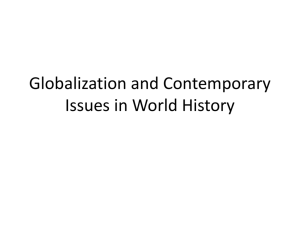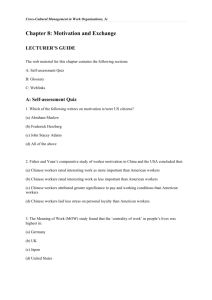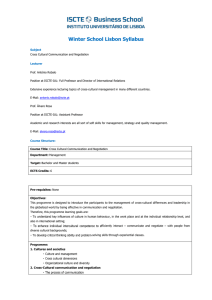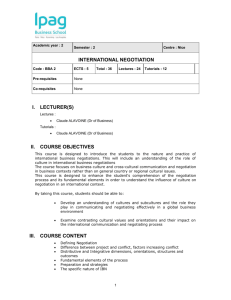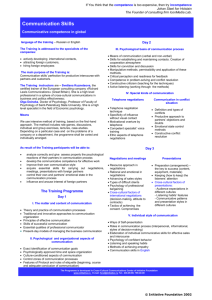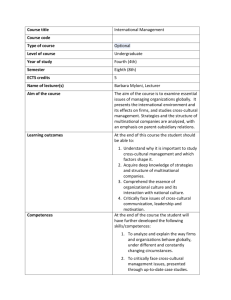Global & Multinational Marketing Strategies
advertisement
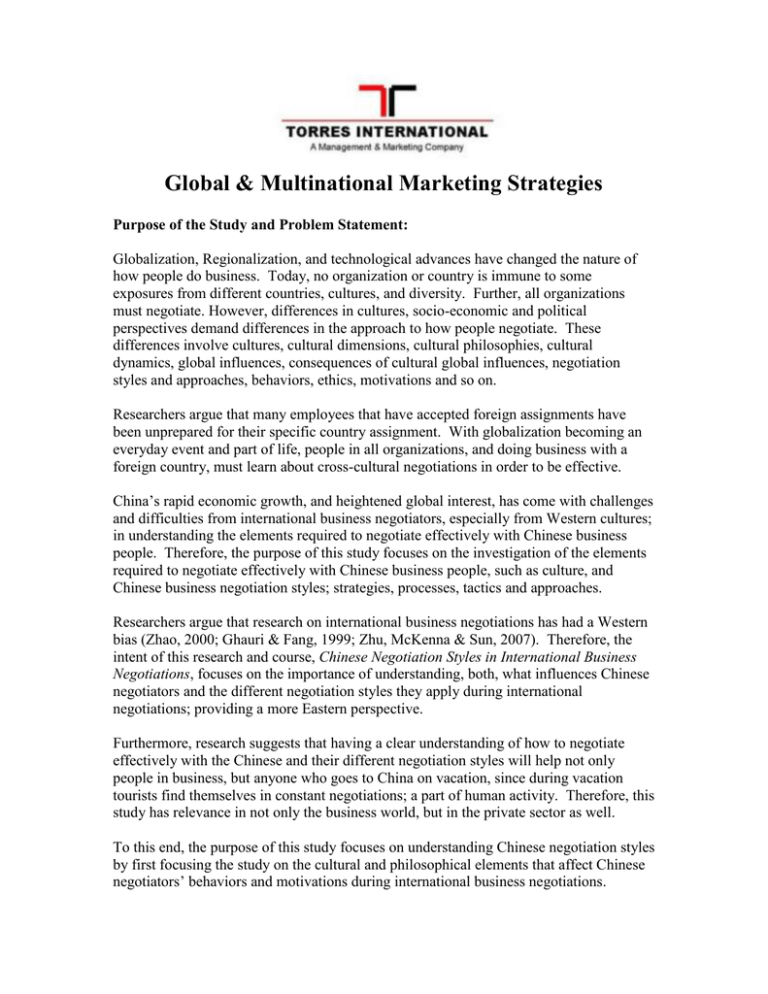
Global & Multinational Marketing Strategies Purpose of the Study and Problem Statement: Globalization, Regionalization, and technological advances have changed the nature of how people do business. Today, no organization or country is immune to some exposures from different countries, cultures, and diversity. Further, all organizations must negotiate. However, differences in cultures, socio-economic and political perspectives demand differences in the approach to how people negotiate. These differences involve cultures, cultural dimensions, cultural philosophies, cultural dynamics, global influences, consequences of cultural global influences, negotiation styles and approaches, behaviors, ethics, motivations and so on. Researchers argue that many employees that have accepted foreign assignments have been unprepared for their specific country assignment. With globalization becoming an everyday event and part of life, people in all organizations, and doing business with a foreign country, must learn about cross-cultural negotiations in order to be effective. China’s rapid economic growth, and heightened global interest, has come with challenges and difficulties from international business negotiators, especially from Western cultures; in understanding the elements required to negotiate effectively with Chinese business people. Therefore, the purpose of this study focuses on the investigation of the elements required to negotiate effectively with Chinese business people, such as culture, and Chinese business negotiation styles; strategies, processes, tactics and approaches. Researchers argue that research on international business negotiations has had a Western bias (Zhao, 2000; Ghauri & Fang, 1999; Zhu, McKenna & Sun, 2007). Therefore, the intent of this research and course, Chinese Negotiation Styles in International Business Negotiations, focuses on the importance of understanding, both, what influences Chinese negotiators and the different negotiation styles they apply during international negotiations; providing a more Eastern perspective. Furthermore, research suggests that having a clear understanding of how to negotiate effectively with the Chinese and their different negotiation styles will help not only people in business, but anyone who goes to China on vacation, since during vacation tourists find themselves in constant negotiations; a part of human activity. Therefore, this study has relevance in not only the business world, but in the private sector as well. To this end, the purpose of this study focuses on understanding Chinese negotiation styles by first focusing the study on the cultural and philosophical elements that affect Chinese negotiators’ behaviors and motivations during international business negotiations. Course Description: This course focuses on the argument that international marketing includes many elements, and issues, beyond domestic marketing, that must be understood, in-depth, in identifying, and developing, relationships with people from many different international markets. The course analyzes numerous elements that occur across national boundaries, such as, but not limited to: different country cultures; the effect of globalization and regionalization on international marketing; international trade; global marketing research; developing and implementing international marketing strategies; understanding countryspecific customers; and international marketing channels and pricing. Further, with the introduction of modern technologies, regionalization and globalization, differences in country-specific economic, political, legal, socio-cultural systems, standardization versus localization, cross-cultural equivalence, institutions, advertising, and infrastructures, the need to understand how to develop and implement effective international marketing strategies in penetrating a foreign country, has never been so important. To this end, this framework will provide a clear foundation for understanding Multinational Marketing Strategies. Learning Outcomes: 1. 2. 3. 4. 5. Understand the international market environment Understand globalization vs. regionalization Understand standardization vs. localization Understand the significance of cross-cultural equivalence in international marketing Develop an understanding of the global and multinational marketing processes and strategies as they apply when marketing products and services in foreign countries 6. Define, recognize, and assess differences in international, multinational, and global marketing 7. Understand the primary components of global marketing research 8. Synthesize body of knowledge related to marketing, culture, and communication 9. Appraise different global marketing strategies 10. Synthesize and evaluate issues related to global and multinational marketing 11. Analyze and assess Marketing’s 4 P strategies in global markets 12. Understand and evaluate ethics when marketing in different countries Suggested Directly Related Reading Materials: o Arnold, D. (2003). The mirage of global markets: How globalizing companies can succeed as markets localize. Upper Saddle River, NJ: Prentice Hall. (ISBN: 0-13047066X) o Banerjee, S. (2008). Dimensions of Indian Culture, core cultural values and marketing implications: An Analysis. Cross Cultural Management, An International Journal, (15)4, 367-378. o Cavusgil, S.T., Civi, E., Tutek, H.H., & Dalgic, T. (2003). Doing business in… Turkey. Thunderbird International Business Review, 45(4). (AN 10253015) o Cateora, P. R., & Graham, J. L. (2002). International Marketing (11th ed.). New York, NY: McGraw-Hill/Irwin. o Cateora, P. R., Gilly, M. C., & Graham, J. L. (2011). International Marketing (15th ed.). New York, NY: McGraw-Hill/Irwin. o Craig, C. S., & Douglas, S. P. (2006). Beyond national culture: Implications of cultural dynamics for consumer research. International Marketing Review, 23, 322. o Czinkota, M.R., & Kotabe, M. (1999). Bypassing barriers to marketing in Japan. Marketing Management, 8(4). (AN 2795277) o Eid, R. & Trueman, M. (2002). The Internet: New international marketing issues. Management Research News, 25(12), 54–67. o Javalgi, R. G., Radulovich, L. P., Pendleton, G., & Scherer, R.F. (2005). Sustainable competitive advantage of Internet firms: A strategic framework and implications for global marketers. International Marketing Review, 22(6), 658–672. o Kragh, S. U., & Djursaa, M. (2001). Product syntax and cross-cultural marketing strategies. European Journal of Marketing, 35(11/12), 1301. o Kumar, V. (2000). International marketing research. Upper Saddle River, NJ: Prentice Hall. (ISBN: 0130453862) o Leo, C., Bennett, R., & Härtel, C. E. J. (2005). Cross-cultural differences in consumer decision-making styles. Cross Cultural Management, 12, 32. o Mahajan. V., & Banga,K. (2006) The 86 percent solution: How to succeed in the biggest market opportunity of the next 50 years. Upper Saddle River, NJ: Prentice Hall. (ISBN: 0132485060) o Okazaki, S. (2004). Do multinationals standardize or localize? The crosscultural dimensionality of product-based Web sites. Internet Research, 14(1), 81. o Torres, J. A. (2011). Market Strategies, Analysis, Competitive Intelligence, and Challenges in Entering the Chinese Market. The Journal of the American Academy of Business, Cambridge, (16)2, 39-46. o Zou, S., & Cavusgil, S. T. (2002). The GMS: A broad conceptualization of global marketing strategy and its effect on firm performance. Journal of Marketing, 66(4), 40–56. It is suggested that students read the “Suggested Directly Related Reading Materials” listed above, in addition to the course lectures, in order to gain a more in-depth understanding of the course content. Related Literature On Course Topic: The complexity of international marketing suggests the need to adopt a broader perspective on the understanding of marketing principles. This perspective should capture the richness and diversity of these different aspects of culture and their influence, as well as the impact of technology (i.e., the internet and so on), advertising, socio-political, economic, and legal systems. Further, effective and successful international negotiations are largely dependent on understanding the other negotiating party’s characteristics, approaches, and culture. Course Outline: Module Topics 1 An Introduction to International Marketing The Scope and Challenge The International Trade Environment 2 The Cultural Environment of Global Markets The Foundation of Culture Culture Dynamics in Assessing Global Markets Cross-Cultural Equivalence Ethics & International Marketing 3 Global Markets Globalization vs. Regionalization Emerging Markets Trading Blocs E-Marketing Multinational Market Regions and Market Groups 4 Global Marketing Research The importance The components (customer needs analysis, satisfaction measurement, competition analysis, and environmental analysis) 5 Developing & Implementing Global & Multinational Marketing Strategy Marketing Entry Strategies The Market Strategy Global Product Branding Cross-Cultural Negotiations Application of the Marketing 4P’s in the Global Marketing Environment 6 Understanding & Choosing Your Customers Creating Value Target Market Selection and Product Positioning 7 International Marketing Channels The Channel Design Framework 8 Pricing for International Markets Framework for Determining Prices
